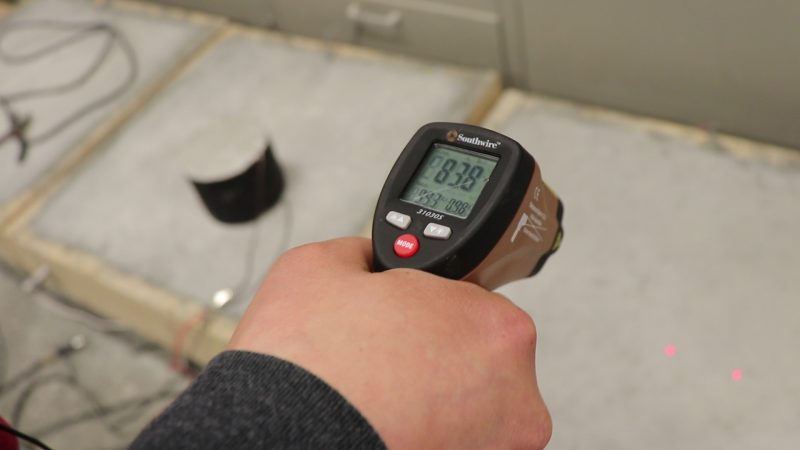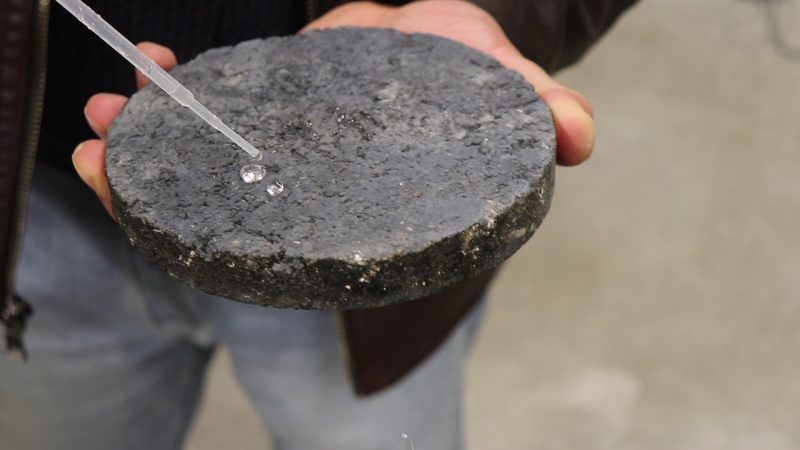InTrans / Jun 11, 2018
Groundbreaking: Electrically conductive concrete
Go! Magazine
 posted on June 11, 2018
posted on June 11, 2018
Imagine a world where fresh snowfall didn’t compromise the ability to drive or bike on roadways. With electrically conductive concrete—concrete that could be heated with an electrical current to melt away snow and ice as it precipitates—that could one day be a reality.
Using this technology, also known as heated pavement, on roadways and sidewalks is still a hope for the future. That said, this technology does exist, and it’s being tested at the Des Moines International Airport. If heated pavement technology continues to move forward, it could truly be a groundbreaking innovation for transportation of the future.
How it started
Halil Ceylan is the director of the Program for Sustainable Pavement Engineering and Research (PROSPER) program and is a professor in the Department of Civil, Construction, and Environmental Engineering at Iowa State University (ISU).

When Ceylan and his team found early success with their electrically-conductive pavement technology in their lab on the ISU campus, it led to conversations with the Director of Engineering and Planning at Des Moines International, who agreed to install test slabs of the concrete at the airport.

In the fall of 2016, Ceylan and his research team installed two test slabs of this electrically conductive concrete off to the side of the airport. If implemented on runways and essential surfaces at airports, such technology could prevent slips, falls, and aircraft from skidding along ice-laden runways. For now, it’s still being tested at the airport and in the lab.
How it works
The test slabs of concrete are made up of a unique mix of cement, sand, and rocks, and are one percent carbon fiber. The carbon fiber is electrically conductive, which therefore allows the concrete to conduct electricity.
There are two layers of concrete that make up the test slabs. The first layer is 4 inches of regular concrete, topped with 3.5 inches of the electrically conductive concrete. Then there are 6 metal electrodes in each test slab, which are connected to the airport’s power supply. The slabs are also equipped with sensors that probe for various measurements like temperature and humidity.

The team that helped to engineer the slabs prepared hundreds of samples in the lab to find the right combination of materials for the finished test product. The concrete had to have the right compressive strength, tensile strength, workability, durability, and electric conductivity.
The team also has a high-grade thermal camera that can help them detect the temperature of their electrically-conductive concrete with thermal images. The camera displays lower temperatures as blues and greens and higher temperatures as yellows, oranges, and reds.
What it costs
Ceylan and his research team have run the numbers for just how much it costs to run the test slabs to melt snow and ice, and it’s about 19 cents per square meter for seven hours—which Ceylan says is more than enough time to melt an inch of snow or ice.

Though installation would cost more than regular pavement, it’s worth noting that this technology would save costs elsewhere. With heated pavement, you wouldn’t have to pay for continuous upkeep like you do with regular pavement, which comes with costs of snow plows, de-icing chemicals, and treating the wastewater for chemical runoff.
And with less chemical runoff going into the soil and surrounding landscape, the environment would be better off, which some would argue is invaluable.
In a partnership with the Federal Aviation Administration (FAA), the team has been provided over $2 million dollars for the full-scale demonstration of “snow- and ice-free airfield pavements” and other studies in heated pavement technology. The funds from the partnership (led by researchers at Purdue University) have been matched by Iowa State University.
A snow- and ice-free future
Ceylan’s team is also working on a super hydrophobic, water-repellent coating that would keep snow and ice from sticking to the pavement to begin with, making it easier to keep it snow- and ice-free.
Can you imagine how much safer our roads, highways, sidewalks, and parking lots would be if they didn’t collect snow and ice in the winter? If you live farther south and don’t know the hassles of winter weather, take it from a Midwesterner that slipping on snow and ice in the winter is no fun—and neither are travel delays and winter weather-induced car crashes!
And with more people choosing to fly than ever before, this technology could reduce flight delays by keeping airport runways clear of snow and ice. Researchers say it would cost about $200 million dollars to install at the essential areas of most airports but would save airports and passengers $273 million dollars—as well as time spent waiting over cancelled flights!
There are solutions that would make our colder environments safer environments, and the groundwork for this technology is being laid at Iowa State University. Iowa, like many other cold regions around the globe, could use a little less snow and ice stuck to the ground in the winter. And it isn’t just about a more convenient world, it’s about a safer world—for humans and aircraft alike.
References
news.iastate.edu/news/2017/03/28/heatedairportpavements
today.com/video/could-heated-airport-runways-solve-winter-travel-woes-1146551875987
Related links
(Video) Heated pavement test slabs — Des Moines International Airport: youtube.com/watch?v=yxFkmHEMtcE
(Video) Could heated airport runways solve winter travel woes? today.com/video/could-heated-airport-runways-solve-winter-travel-woes-1146551875987
By Hannah Postlethwait, Go! Staff Writer